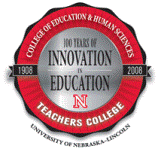Education and Human Sciences, College of (CEHS)
Abstract
Reading First has been implemented in Nebraska since the 2004-5 academic year. In two rounds of funding and participation, schools have transformed the way they trained their teachers, measured student progress, and taught. This transformation is one of the hardest tasks in education and it has taken the considerable dedication of school personnel as well as dedicated leaders from the Nebraska Department of education. The program has seen great success in increasing the proportion of students acquiring basic literacy skills of phonemic awareness, decoding, and oral reading fluency. That initial success has led to an increase in outcomes even for comprehension and vocabulary areas that are much harder to remediate. It is clear, however, that a program such as Reading First has very clear limitations. That is beyond an initial improvement of 10-15% (by no means a trivial one) over the first 2 years of implementation, other gains are small and inconsistent. The program is able to "hold the line" even with large number of mobile students but not to go any further. This trend is reinforced if we look at the results of the Nebraska State Assessment in reading as presented in the table below. Nine schools are at or above the state average (if standard error is taken into account), while fifteen are significantly below state average. The reasons for schools success in meeting the established goals seem to be associated with two factors. The first factor is related to the students showing up at the schools door. For example state test scores show that there is a significant relationship between average district results and the percent of students who receive Free and Reduced Lunch (the correlation is -.94). At the same time individual school results show that school leadership and instructional focus can overcome some of these challenges and make significant gains. Finally, school reform that is meaningful takes more than three four or even five years. Future efforts must be based on sustained efforts that research has shown to be effective in an average of seven years.


Comments
ANNUAL REPORT, YEAR SIX OF IMPLEMENTATION: 2009-2010
Issued by College of Education and Human Sciences, University of Nebraska-Lincoln